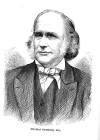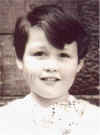|
Rev. Thomas Guthrie and “The Ragged Schools”

Thomas Guthrie was another man of vision and philanthropy
who in his day did much for the children of Scotland.
Guthrie was born in Brechin on July 12, 1803, the 12th
child and sixth son of David Guthrie and Clementina Cay.
His father was a
merchant and banker in Arbroath, and Provost in the town of Brechin for many years. His grandfather, a farmer, was a devout man, who lived till eighty seven years of age. The grandparents` house was something akin to a church shaped as it was by the fervour in which grandfather conducted family worship and the saying of grace at meal times. He was a very kindly man and spoilt his grandchildren, contrasting somewhat with the grandmother who was a disciplinarian and had a stern regard for what she perceived as her religious duty. The young Thomas was a precocious child and preferred reading his books rather than playing with other children. He went to Edinburgh University at the
age of 12 where he spent his time in literary and philosophic studies for four years, four as a divinity student, and a further two years on surgery and anatomy. He
completed the eight year divinity curriculum by 1825 – two
years before he could be licensed as a minister, and was able to spend the time at the Sorbonne in Paris.
For a while he managed a savings bank (previously operated by his father and a brother) for
his parishioners as had the Rev. Henry Duncan of
Ruthwell
who started the savings bank movement in 1810.
In 1829 he was appointed to the Parish of Arbirlot near
Forfar where he introduced a special church service for
children every Sunday afternoon. He soon became a
“pictorial” preacher, illustrating his sermons with events
in common life that were familiar to the people. At night on the Sabbath he held classes for young people where he held examinations in the Catechism, a review of the morning`s sermon, and concluded with a short lecture of about fifteen minutes in length. Significantly these evening sessions were soon attended by many older persons as well as the young. He also
started a village library, all of which enhanced his
growing reputation. The Rev Thomas McCrie spent a day with Guthrie and is said to have observed that “he will not be long there”, meaning men of talent were soon called upon by others. So it was for the Rev Thomas Guthrie..
In 1837, Guthrie was invited to be minister at the Old
Greyfriars Kirk in Edinburgh where he saw at first hand
the “ragged children” who lived by begging and
stealing amongst the poverty and

squalor of the Old Town in which his church was set. He had probably heard of “Ragged
Schools” which had been set up in England in 1820 and
around the same time, Sheriff Watson in Aberdeen had
formed his “Industrial Feeding School” in 1841. Guthrie converted a room beneath the church for the making of soup and porridge and he soon had his first class attending. Within a year there were three Ragged Schools in Edinburgh with an attendance of two hundred and sixty five children.
In 1847, Rev. Guthrie began his campaign with a pamphlet
entitled “Plea for Ragged Schools” which spoke of
“bloated and brutal figures.. fierce looking women, and many a half clad mother, shivering in cold winter, her naked feet on the frozen pavement, a skeleton infant in her arms.”
The pamphlet went on to say,
“Dashing in and out of the closes careering over the open ground engaged in rude games, arrayed in flying drapery here a leg out and their an arm, are crowds of children; their faces tell how ill they are fed; their fearful oaths tell how ill they are reared.”
“These Arabs of the city are as those of the desert, and
must be broken in to three habits – those of discipline,
learning and industry, not to speak of cleanliness.”
 Public Public
subscriptions raised over £2000. and he was able to take
seven boys as pupils at the Ragged School in Free St.
Johns Church. Further premises were opened in Ramsay Lane,
where over the entrance is a carved bible with the text
“Search the Scriptures”.
The prime rule of the schools was to reclaim the children
from destitution and train them to earn an honest living.
They were well fed and educated about cleanliness,
godliness, reading, writing and taught skills including
cobbling, tailoring, and cooking. By doing jobs for local
shops the children were able to earn a small wage and were
instilled with “the value of a penny earned.”
Over 500 children
passed through the schools in their first year. The effect
of his efforts, it is said, was to clear the streets of
young beggars and reduce the number of children held in
prison by three-quarters – a phenomenal success story. An amusing cameo is painted of drinkers in an unlicensed bar in Glasgow, discussing with raucous epithets the merits and mostly demerits of ministers, when one fellow interposed : the conversation went like this :
“I`ll tell you a gude man, a really gude man ” ” Wha`s that !? “That`s just Tam Guthrie ” “Ay ! you`ve said it now.” “I believe Dr Guthrie to be as a gude a man as ever waggit his head in a poopit.”; he`s different fare the ithers a`thegither; he practices mair than he preaches.”
Guthrie was also involved with other good works including the Board of the Royal Infirmary; a Home for Fallen Women, the Blind Asylum and a House of Refuge. He was also involved with the Temperance legislation and produced a booklet ” The City, its Sins and its Sorrows” that ran to 50,000 copies when published. His efforts led to changes in 1853 to the licensing hours for public houses and closed them completely on Sunday. In 1862 he was elected Moderator of the General Assembly of the Free Church of Scotland, for whom he worked most diligently on behalf of the Manse Fund, and saw the provision of very many manses throughout the country.
Widely travelled throughout Europe America and Australia
he was an acquaintance of Harriet Beecher Stowe while luminaries such as Thackeray, Ruskin and Gladstone extolled his labours. He had
fundraising assistance from Jenny Lind, the Swedish
Nightingale, of whom he wrote in 1861:
“I should have liked very much to meet Jenny Lind that I
might personally thank her .. for the £50 she sang out of
the public for our Ragged Schools, last time she was
here.”
There were, too, some floating Ragged Schools such as the
“Akbar” an old man of war converted to a training ship. In
the Tay estuary was the “Mars” and the “Cumberland” on the
Clyde.
Guthrie retired in 1864 and died on February 23, 1873, in
St. Leonards on Sea, in Sussex, surrounded by his wife and eight of their ten children. He was interred in Edinburgh on Friday February 28, 1873, with his funeral procession watched by 30,000 bystanders. 230 children from the Original Ragged Schools attended the graveside and sang “There is a happy land, far, far away”.
A fitting epitaph surely are the words of a little girl from one of the schools:
“He was all the father I ever knew.”
Next : Dr
William Buchan.
|